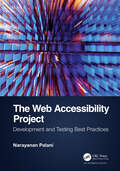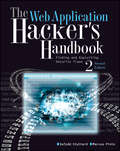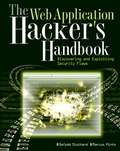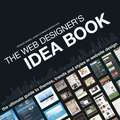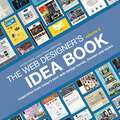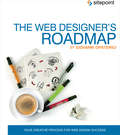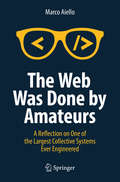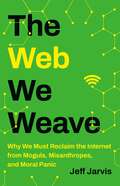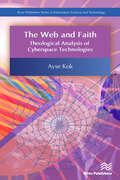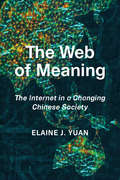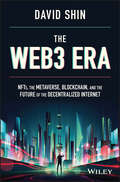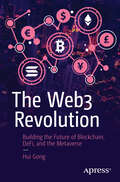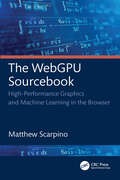- Table View
- List View
The Web Accessibility Project: Development and Testing Best Practices
by Narayanan PalaniApproximately 15% of the global population is affected by some sort of disability, according to the World Report on Disability. Many C-Suite executives perceive digital accessibility (DA) as an endless task. Among the engineering leaders, one in four leaders are reliant on very limited knowledge about digital accessibility. Many countries are increasing their legislative efforts to make web accessibility an important part in web development and testing of software releases. Numerous organizations are facing extreme turbulence when not adhering to international accessibility guidelines while developing their software’s and website applications. Web Content Accessibility Guidelines (WCAG) is a global guide on accessibility recommendations that are developed through the World Wide Web Consortium (W3C) to help organizations to meet minimum standard accessibility guidelines. It has become critical for every organization to focus on implementing the accessibility checks at every stage of their application development to avoid costly mistakes. Meanwhile, the need for front-end engineers and Quality Assurance (QA) test analysts to learn WCAG best practices is immensely important for the growing need to incorporate accessibility-focused inclusive design, development, and extensive accessibility testing, which are essential for most of the customer-facing websites. In a fast-paced world, incorporating shift left accessibility within development and testing is the new normal. The Web Accessibility Project: Development and Testing Best Practices helps developers address right accessibility attributes to user interface (UI) components. It also helps developers focus on developing manual and automation tests for QA professionals to inject accessibility audit, accessibility functional tests, and accessibility automation tests as part of their Continuous Integration and Continuous Development (CI/CD) models. The book is filled with readily usable best practices to adapt web accessibility early in application development. By applying the accessibility best practices covered in this book, developers can help their organizations rise to a whole new level of accessibility adherence, innovation, and inclusive design. They will also see greater work satisfaction in their professional lives and a way to help improve digital accessibility for end users.
The Web Application Hacker's Handbook
by Dafydd Stuttard Marcus PintoThe highly successful security book returns with a new edition, completely updatedWeb applications are the front door to most organizations, exposing them to attacks that may disclose personal information, execute fraudulent transactions, or compromise ordinary users. This practical book has been completely updated and revised to discuss the latest step-by-step techniques for attacking and defending the range of ever-evolving web applications. You'll explore the various new technologies employed in web applications that have appeared since the first edition and review the new attack techniques that have been developed, particularly in relation to the client side.Reveals how to overcome the new technologies and techniques aimed at defending web applications against attacks that have appeared since the previous editionDiscusses new remoting frameworks, HTML5, cross-domain integration techniques, UI redress, framebusting, HTTP parameter pollution, hybrid file attacks, and moreFeatures a companion web site hosted by the authors that allows readers to try out the attacks described, gives answers to the questions that are posed at the end of each chapter, and provides a summarized methodology and checklist of tasksFocusing on the areas of web application security where things have changed in recent years, this book is the most current resource on the critical topic of discovering, exploiting, and preventing web application security flaws.
The Web Application Hacker's Handbook: Discovering and Exploiting Security Flaws
by Dafydd Stuttard Marcus PintoThis book is a practical guide to discovering and exploiting security flaws in web applications. The authors explain each category of vulnerability using real-world examples, screen shots and code extracts. The book is extremely practical in focus, and describes in detail the steps involved in detecting and exploiting each kind of security weakness found within a variety of applications such as online banking, e-commerce and other web applications. The topics covered include bypassing login mechanisms, injecting code, exploiting logic flaws and compromising other users. Because every web application is different, attacking them entails bringing to bear various general principles, techniques and experience in an imaginative way. The most successful hackers go beyond this, and find ways to automate their bespoke attacks. This handbook describes a proven methodology that combines the virtues of human intelligence and computerized brute force, often with devastating results. The authors are professional penetration testers who have been involved in web application security for nearly a decade. They have presented training courses at the Black Hat security conferences throughout the world. Under the alias "PortSwigger", Dafydd developed the popular Burp Suite of web application hack tools.
The Web Collection Revealed Premium Edition: Adobe Dreamweaver CS6, Flash CS6, & Photoshop CS6
by Elizabeth Eisner Reding Sherry Bishop Jim ShumanYou can now maximize and integrate the design and development power of Adobe Creative Suite 6 with WEB COLLECTION REVEALED PREMIUM EDITION. This one of a kind text features Adobe Dreamweaver, Adobe Flash, and Adobe Photoshop in one resource, and provides practical experience with each software application through projects and learner-friendly tutorials. Also a full chapter on integration demonstrates how to move effortlessly from one application to another, while Power User Shortcuts and New Features icons point out key changes effective with the release of CS6. WEB COLLECTION REVEALED PREMIUM EDITION provides the information and practice you need to build professional-quality Websites, using all three of these Adobe applications! The Data Files used to complete the projects found in the book are now available online. For access information please refer to the directions available in the preface of the book.
The Web Collection Standard Edition: Revealed
by Sherry Bishop Jim Shuman Barbara WaxerThis comprehensive introductory book provides step-by-step instruction and in-depth explanation on three of today's most widely used Web design and development programs: Adobe Dreamweaver CS3, Adobe Flash CS3, and Adobe Fireworks CS3. Readers gain practical experience with the software as they work through end-of-chapter learning projects and step-by-step tutorials. An integration chapter demonstrates how to move from one application to the other while creating a Dreamweaver Web site that incorporates both Flash and Fireworks files. Full-color illustrations and a user-friendly design combine to create a solid learning experience that reveals how to master the latest features of these popular applications.
The Web Collection: Adobe Dreamweaver CS3, Flash CS3, and Fireworks CS3 Revealed
by Sherry Bishop James E. Shuman Barbara M. WaxerThis comprehensive introductory book provides step-by-step instruction and in-depth explanation on three of today's most widely used Web design and development programs: Adobe Dreamweaver CS3, Adobe Flash CS3, and Adobe Fireworks CS3. Readers gain practical experience with the software as they work through end-of-chapter learning projects and step-by-step tutorials. An integration chapter demonstrates how to move from one application to the other while creating a Dreamweaver Web site that incorporates both Flash and Fireworks files. Full-color illustrations and a user-friendly design combine to create a solid learning experience that reveals how to master the latest features of these popular applications.
The Web Designer's Idea Book
by Patrick McneilInspiring Web Design at a GlanceThe Web Designer's Idea Book includes more than 700 websites arranged thematically, so you can find inspiration for layout, color, style and more. Author Patrick McNeil has cataloged more than 5,000 sites on his website, and showcased in this book are the very best examples.Sites are organized by type, design style, theme, color, element and structure. Each chapter is easy to use and reference again and again, whether you're talking with a coworker or discussing website design options with a client. As a handy desk reference for design layout, color and style, this book is a must-have for starting new projects.
The Web Designer's Idea Book Volume 2
by Patrick McneilWeb Design Inspiration at a GlanceVolume 2 of The Web Designer's Idea Book includes more than 650 new websites arranged thematically, so you can easily find inspiration for your work. Author Patrick McNeil, creator of the popular web design blog designmeltdown.com and author of the original bestselling Web Designer's Idea Book, has cataloged thousands of sites, and showcases the latest and best examples in this book. The web is the most rapidly changing design medium, and this book offers an organized overview of what's happening right now. Sites are categorized by type, design element, styles and themes, structural styles, and structural elements. This new volume also includes a helpful chapter explaining basic design principles and how they can be applied online. Whether you're brainstorming with a coworker or explaining your ideas to a client, this book provides a powerful communication tool you can use to jumpstart your next project.
The Web Designer's Idea Book Volume 2
by Patrick McneilWeb Design Inspiration at a GlanceVolume 2 of The Web Designer's Idea Book includes more than 650 new websites arranged thematically, so you can easily find inspiration for your work. Author Patrick McNeil, creator of the popular web design blog designmeltdown.com and author of the original bestselling Web Designer's Idea Book, has cataloged thousands of sites, and showcases the latest and best examples in this book. The web is the most rapidly changing design medium, and this book offers an organized overview of what's happening right now. Sites are categorized by type, design element, styles and themes, structural styles, and structural elements. This new volume also includes a helpful chapter explaining basic design principles and how they can be applied online. Whether you're brainstorming with a coworker or explaining your ideas to a client, this book provides a powerful communication tool you can use to jumpstart your next project.
The Web Designer's Idea Book Volume 2: More of the Best Themes, Trends and Styles in Website Design
by Patrick McneilWeb Design Inspiration at a GlanceVolume 2 of The Web Designer's Idea Book includes more than 650 new websites arranged thematically, so you can easily find inspiration for your work. Author Patrick McNeil, creator of the popular web design blog designmeltdown.com and author of the original bestselling Web Designer's Idea Book, has cataloged thousands of sites, and showcases the latest and best examples in this book. The web is the most rapidly changing design medium, and this book offers an organized overview of what's happening right now. Sites are categorized by type, design element, styles and themes, structural styles, and structural elements. This new volume also includes a helpful chapter explaining basic design principles and how they can be applied online.Whether you're brainstorming with a coworker or explaining your ideas to a client, this book provides a powerful communication tool you can use to jumpstart your next project.
The Web Designer's Idea Book, Volume 3
by Patrick McneilQuick Inspiration for Web Designers Featuring more than 650 examples, this third volume of The Web Designer's Idea Book is packed with visual inspiration for creating top-notch web design. Web design expert Patrick McNeil, author of the popular Web Designer's Idea Book series, is back with the latest examples of the best design on the web today. Arranged thematically, this guide puts important topics like technology, design styles, elements, site types and site structure at your fingertips. This new volume also includes a detailed discussion of the various content management systems available to help you find the best platform for your project. An indispensable reference, this book provides you with the latest in themes, styles and trends you need to keep your projects relevant in the fast-paced and every-changing world of web design.
The Web Designer's Idea Book, Volume 3: Inspiration from Today's Best Web Design Trends, Themes and Styles
by Patrick McneilQuick Inspiration for Web DesignersFeaturing more than 650 examples, this third volume of The Web Designer's Idea Book is packed with visual inspiration for creating top-notch web design. Web design expert Patrick McNeil, author of the popular Web Designer's Idea Book series, is back with the latest examples of the best design on the web today.Arranged thematically, this guide puts important topics like technology, design styles, elements, site types and site structure at your fingertips. This new volume also includes a detailed discussion of the various content management systems available to help you find the best platform for your project.An indispensable reference, this book provides you with the latest in themes, styles and trends you need to keep your projects relevant in the fast-paced and every-changing world of web design.
The Web Designer's Idea Book, Volume 3: Inspiration from Today's Best Web Design Trends, Themes and Styles
by Patrick McneilQuick Inspiration for Web DesignersFeaturing more than 650 examples, this third volume of The Web Designer's Idea Book is packed with visual inspiration for creating top-notch web design. Web design expert Patrick McNeil, author of the popular Web Designer's Idea Book series, is back with the latest examples of the best design on the web today.Arranged thematically, this guide puts important topics like technology, design styles, elements, site types and site structure at your fingertips. This new volume also includes a detailed discussion of the various content management systems available to help you find the best platform for your project.An indispensable reference, this book provides you with the latest in themes, styles and trends you need to keep your projects relevant in the fast-paced and every-changing world of web design.
The Web Designer's Idea Book: The Ultimate Guide To Themes, Trends & Styles In Website Design
by Patrick McneilInspiring Web Design at a GlanceThe Web Designer's Idea Book includes more than 700 websites arranged thematically, so you can find inspiration for layout, color, style and more. Author Patrick McNeil has cataloged more than 5,000 sites on his website, and showcased in this book are the very best examples.Sites are organized by type, design style, theme, color, element and structure. Each chapter is easy to use and reference again and again, whether you're talking with a coworker or discussing website design options with a client. As a handy desk reference for design layout, color and style, this book is a must-have for starting new projects.
The Web Designer's Idea Book: The Ultimate Guide To Themes, Trends & Styles In Website Design
by Patrick McneilInspiring Web Design at a GlanceThe Web Designer's Idea Book includes more than 700 websites arranged thematically, so you can find inspiration for layout, color, style and more. Author Patrick McNeil has cataloged more than 5,000 sites on his website, and showcased in this book are the very best examples.Sites are organized by type, design style, theme, color, element and structure. Each chapter is easy to use and reference again and again, whether you're talking with a coworker or discussing website design options with a client. As a handy desk reference for design layout, color and style, this book is a must-have for starting new projects.
The Web Designer's Idea Book: The Ultimate Guide to Themes, Trends and Styles in Website Design
by Patrick McneilInspiring Web Design at a Glance The Web Designer's Idea Bookincludes more than 700 websites arranged thematically, so you can find inspiration for layout, color, style and more. Author Patrick McNeil has cataloged more than 5,000 sites on his website, and showcased in this book are the very best examples. Sites are organized by type, design style, theme, color, element and structure. Each chapter is easy to use and reference again and again, whether you're talking with a coworker or discussing website design options with a client. As a handy desk reference for design layout, color and style, this book is a must-have for starting new projects.
The Web Designer's Roadmap: Your Creative Process for Web Design Success
by Giovanni DiFetericiThe Web Designer's Roadmap is a full-color book about the creative process and the underlying principles that govern that process. While other books cover the nuts 'n' bolts of how to design the elements that make up websites, this book outlines how effective designers go about their work, illustrating the complete creative process from start to finish. As well as how-to content, the book draws on interviews with a host of well-known design gurus, including Shaun Inman, Daniel Burka, Meagan Fisher, Donald Norman and Dan Rubin. A non-academic book, this is a fun and easy read packed with practical information.
The Web Was Done by Amateurs: A Reflection on One of the Largest Collective Systems Ever Engineered
by Marco AielloThis book stems from the desire to systematize and put down on paper essential historical facts about the Web, a system that has undoubtedly changed our lives in just a few decades. But how did it manage to become such a central pillar of modern society, such an indispensable component of our economic and social interactions? How did it evolve from its roots to today? Which competitors, if any, did it have to beat out? Who are the heroes behind its success?These are the sort of questions that the book addresses. Divided into four parts, it follows and critically reflects on the Web’s historical path. “Part I: The Origins” covers the prehistory of the Web. It examines the technology that predated the Web and fostered its birth. In turn, “Part II: The Web” describes the original Web proposal as defined in 1989 by Tim Berners-Lee and the most relevant technologies associated with it. “Part III: The Patches” combines a historical reconstruction of the Web’s evolution with a more critical analysis of its original definition and the necessary changes made to the initial design. In closing, “Part IV: System Engineering” approaches the Web as an engineered infrastructure and reflects on its technical and societal success.The book is unique in its approach, combining historical facts with the technological evolution of the Web. It was written with a technologically engaged and knowledge-thirsty readership in mind, ranging from curious daily Web users to undergraduate computer science and engineering students.
The Web We Weave: Why We Must Reclaim the Internet from Moguls, Misanthropes, and Moral Panic
by Jeff JarvisA bold defense of the internet, arguing attempts to fix and regulate it are often misguided —"essential reading for anyone who cares about the future of the internet" (Taylor Lorenz, author of Extremely Online) The internet stands accused of dividing us, spying on us, making us stupid, and addicting our children. In response, the press and panicked politicians seek greater regulation and control, which could ruin the web before we are finished building it. Jeff Jarvis is convinced we can have a saner conversation about the internet. Examining the web&’s past, present, and future, he shows that many of the problems the media lays at the internet&’s door are the result of our own failings. The internet did not make us hate; we brought our bias, bigotry, and prejudice with us online. That&’s why even well-intentioned regulation will fail to fix hate speech and misinformation and may instead imperil the freedom of speech the internet affords to all. Once we understand the internet for what it is—a human network—we can reclaim it from the nerds, pundits, and pols who are in charge now and turn our attention where it belongs: to fostering community, conversation, and creativity online. The Web We Weave offers an antidote to today&’s pessimism about the internet, outlining a bold vision for a world with a web that works for all of us.
The Web and Faith: Theological Analysis of Cyberspace Technologies
by Ayse KokComputing technology is an indispensable feature of modern life. Our rapid-paced world seems more and more remote from the world narrated in sacred scriptures. However, despite its pervasiveness, there remains a dearth of theological reflection about computer technology and what it means to live as a faithful individual in a digitally - saturated society.The Web and Faith provides a brief theology of technology, rooted in the Islamic tradition and oriented around the grand themes of creation, redemption and new creation. The book combines a concise, accessible style with penetrating cultural and theological analysis. Building on the work of Marshall McLuhan and Neil Postman, and drawing from a wide range of enlightened Islamic thinkers, the book situates computer technology within the big picture of the story of creation. Technology is not neutral, but neither is there an exclusively ''faith-based'' form of technological production and use. Instead, this book guides us to see the digital world as part of a larger creation, which is redeemable according to the law of faith. Responsibly used, technology can become an integral part of religious wisdom world-wide.
The Web of Meaning: The Internet in a Changing Chinese Society
by Elaine Jingyan YuanTaking off at the height of China’s socio-economic reforms in the mid-1990s, the Internet developed alongside the twists and turns of the country’s rapid transformation. Central to many aspects of social change, the Internet has played an indispensable role in the decentralization of political communication, the expansion of the market, and the stratification of society in China. Through three empirical cases – online privacy, cyber-nationalism, and the network market – this book traces how different social actors engage in negotiation of the practices, social relations, and power structures that define these evolving institutions in Chinese society. Examining rich user-generated social media data with innovative methods such as semantic network analysis and topic modelling, The Web of Meaning provides a solid empirical base to critiquefor critiquing the power relationships that are embedded in the very fibreer of Chinese society.
The Web3 Era: NFTs, the Metaverse, Blockchain, and the Future of the Decentralized Internet
by David ShinGet a sneak peek into the future of technology, finance, and the metaverse In The Web3 Era: NFTs, the Metaverse, Blockchain and the Future of the Decentralized Internet, renowned finance and technology expert David Shin connects pivotal moments from the history of human progress and global trade with current events that are shaping the world of tomorrow through a fascinating and insightful exploration of the long-term, next-level use cases of non-fungible tokens and digital assets, and their implications for industries that leverage these advancements. In the book, you’ll find discussions of the challenges and opportunities for institutions awaiting the arrival of the Web3 space; how old Western central powers are struggling to keep up with the digital currencies of the East; and why our voices will matter as consensus-driven tribes converge to form DAOs. You’ll also discover the potential of blockchain as a pivotal engine for driving the metaverse economy and transforming contemporary web infrastructure into a decentralized network of free trade and social interaction governed by users themselves. The author covers topics that include: The potential institution of a smart treasury in a digital economy The convergence of metaverse infrastructure with decentralized finance, creating a virtual world of open finance Use cases for government-backed digital tokens in a variety of industries, including education, healthcare, and banking Social interactions and commerce tied to Soulbound-identity, A.I. technology, archeological revelations, de-dollarization, and the rising Global SouthAn essential and one-of-a-kind resource for business leaders, executives, entrepreneurs, investors, and finance professionals, The Web3 Era: NFTs, the Metaverse, Blockchain and the Future of the Decentralized Internet will also benefit technology enthusiasts, digital marketers, and digital transformation specialists who seek to gain invaluable insights into the future of technology and finance, as well as anyone who believes that we are in need of a new system of governance for a better tomorrow.
The Web3 Revolution: Building the Future of Blockchain, DeFi, and the Metaverse
by Hui GongWe stand on the cusp of a digital revolution, with Web3 technologies gaining momentum and proving pivotal in shaping the future of finance, art, governance, and social interactions. This comprehensive guide is designed to navigate the intricate world of Web3. Organized in four parts, it offers insightful analysis and explanations on blockchain technology, decentralized finance (DeFi), and the burgeoning realm of the metaverse, providing readers with a holistic understanding of their current state and future potential. Part 1 lays the groundwork by exploring the origins and fundamentals of blockchain technology. From the inception of blockchain and its mechanisms such as hash functions, encryption, and consensus algorithms, to a deep dive into Bitcoin, this section elucidates its operational mechanisms and reflects on its profound impact and the challenges it faces. Part 2 shifts focus to Ethereum and smart contracts, dissecting how Ethereum has expanded blockchain capabilities beyond mere currency. This part covers the details of smart contracts, their applications, the ERC standards that have fostered a plethora of tokens and applications, and Layer 2 solutions essential for scalability. Part 3 delves into DeFi and its applications, elucidating how traditional financial services are being revolutionized. It explores core concepts, mainstream protocols, and unpacks the inherent risks and challenges of DeFi, as well as examining tokenized real-world assets and NFTs, showing how blockchain bridges the digital and physical worlds. Part 4 explores the Web3 ecosystem, focusing on the metaverse and decentralized exchanges. You’ll learn about the metaverse’s potential to create parallel digital worlds, the mechanics of decentralized exchanges, and understand strategies crucial for investment and growth in this space. Whether you are a tech enthusiast, investor, entrepreneur, or simply curious about the future of the internet, The Web3 Revolution provides the essential knowledge to navigate, understand, and prepare for the decentralized future. What You’ll Learn Explore the core of Web3 with in-depth analysis, practical DeFi case studies, and a visionary outlook on its societal impact. Unpack the complexities of blockchain, DeFi, and the metaverse with an extensive and thorough examination, from foundational technologies to futuristic applications. Gain practical insights through detailed case studies on cryptocurrencies and DeFi protocols, coupled with an expert outlook on emerging challenges and how to navigate them. Equip yourself with a forward-looking perspective that illuminates the transformative impact of Web3 on sectors like finance, art, governance, and societal structures, preparing you for the new digital era. Who This Book Is For Tech enthusiasts, investors, entrepreneurs, and those interested in the future of the internet
The WebGPU Sourcebook: High-Performance Graphics and Machine Learning in the Browser
by Matthew ScarpinoThe WebGPU Sourcebook: High-Performance Graphics and Machine Learning in the Browser explains how to code web applications that access the client’s graphics processor unit, or GPU. This makes it possible to render graphics in a browser at high speed and perform computationally intensive tasks such as machine learning. By taking advantage of WebGPU, web developers can harness the same performance available to desktop developers.The first part of the book introduces WebGPU at a high level, without graphics theory or heavy math. The chapters in the second part are focused on graphical rendering and the rest of the book focuses on compute shaders.This book walks through several examples of WebGPU usage. It also: Discusses the classes and functions defined in the WebGPU API and shows how they’re used in practice Explains the theory of graphical rendering and shows how to implement rendering inside a web application Examines the theory of neural networks (machine learning) and shows how to create a web application that trains and executes a neural network
The Webinar Manifesto
by Treion Muller Matthew MurdochWe're declaring war on bad webinars, and we want you to join us.We are looking for Sales and Marketing Professionals, HR Managers, Trainers, and Instructional Designers (regardless of skill level) who are disgusted with mundane, ineffective and crappy webinars.The Webinar Manifesto provides the seven strategies essential to captivate your audience, push the limits of your technology, and transform webinar design and delivery.Unlike traditional how-to books, this Manifesto digs deep into principles and behaviors--not just tactics--required for a revolutionary change of yesterday's ugly webinars.If you're serious about change in this industry then join the movement and never design, deliver, or sell lousy webinars again!Go now to TheWebinarManifesto.com to sign "the" manifesto as well as get some free stuff--The Webinar Manifesto poster and audio downloads from our first book, The Learning Explosion: 9 Rules to Ignite Your Virtual Classroom.ABOUT THE AUTHORSFor over 20 years, Matt Murdoch has held many strategic management roles, including Head of Corporate Marketing and Global Director of Online Learning.Through extensive travel throughout Asia, Europe, the Middle East and the Americas, Matt spends time helping partners and clients analyze, build, and launch their own social learning and virtual classroom systems. Matt is the co-author of The Learning Explosion: 9 Rules to Ignite Your Virtual Classrooms and The Webinar Manifesto: Never Design, Deliver, or Sell Lousy Webinars Again! Matt counsels business leaders everywhere that they shouldn't be frightened by new ideas. They should be more frightened by old ones. A rising generation of workers is coming, bringing with them their own rules for how they choose to learn.He enjoys summer and winter outdoor activities in the Rocky Mountains where he lives with his wife, four children and a spirited dog named Lola.Treion Muller is an author, blended learning authority, social learning expert, and eLearning thought leader. He is currently FranklinCovey's Director of Digital Learning Solutions Development.Treion holds a masters degree in Instructional Design from Utah State University with an emphasis in blended learning, and is the co-author of The Learning Explosion: 9 Rules to Ignite Your Virtual Classrooms and The Webinar Manifesto: Never Design, Deliver, or Sell Lousy Webinars Again! He has also authored Dad Rules: A Simple Manual for a Complex Job. Combined with his avid research and knowledge of technology and social media, and his rich experience in instructional design, corporate training, and sales, Treion regularly presents on the future of eLearning and online training.Treion lives in the Rocky Mountains with his wife and five children.
